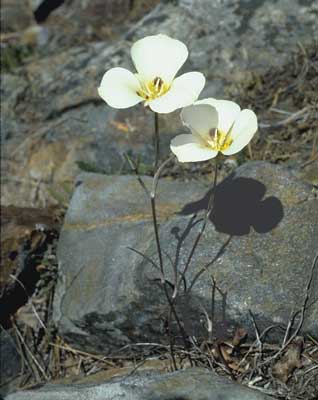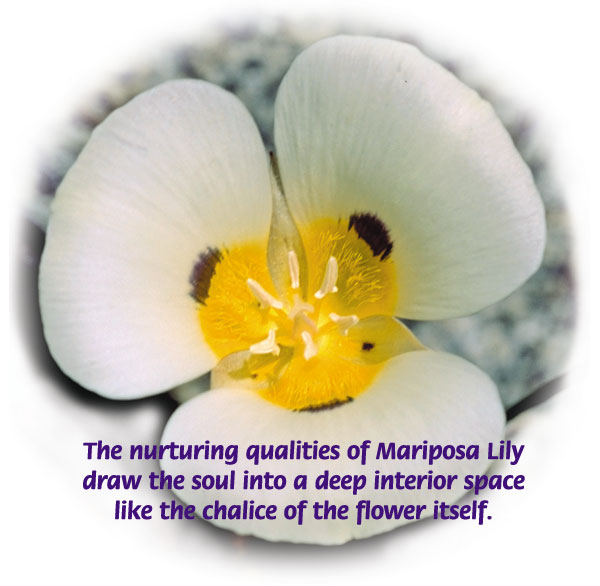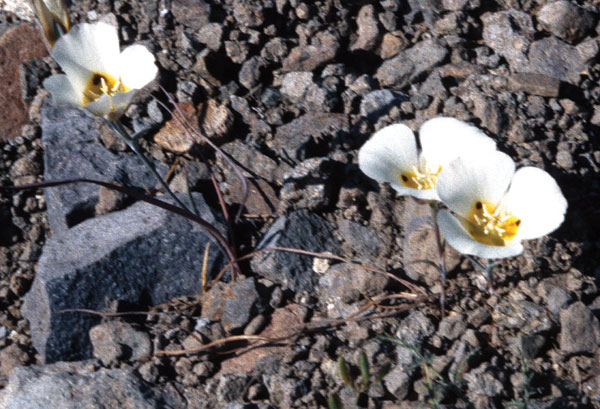Mariposa Lily in the Soul of Natureby Patricia Kaminski
Mariposa Lily (Calochortus leichtlinii)
is a native American wildflower found in California's Sierra Nevada mountains, growing from 4000 to 12,000 feet (1200 to 3600 meters), at home in granite outcroppings, especially along exposed hillsides and ridges. The
Calochortus
genus is richly varied and also includes other flower essence plants such as Star Tulip, Yellow Star Tulip, Fairy Lantern and the Splendid Mariposa Lily.
Calochortus
comes from the Greek words
kalos
, meaning beautiful, and
chortus
, meaning grass: a beautiful flowered plant with the grass-like leaves.
Mariposa
is the Spanish word for butterfly, referring to the evanescent quality of the petals and unique markings on the flowers.
|
|

The Mariposa Lily and other Calochortus species belong to the Lily Family (Liliaceae), with other flower essence plant members like White Trumpet (Easter) Lily, Tiger Lily, Aloe Vera, Desert Lily, Shasta Lily, Trillium, Garlic, Pretty Face and Star of Bethlehem. Lily Family plants are all monocotyledons, meaning that they have one seed leaf. The monocots have long, linear leaves with parallel veins (as in the grasses, for example), with their characteristic bulbs and flowers with three sepals and three petals (or six petals). |
|
 Liliaceae have a strong affinity for water, and grow near water, or store water in their bulbs. In fact, the geometry of the six-pointed flower form of the lilies is emblematic of water itself—when water crystallizes as ice or snow, it manifests as infinite variations of a hexagram (a six-sided figure). While the roots of lilies remain in the water element and are not so deeply attached in the earth, the flowers have ethereal qualities, and sweet and evocative fragrances that are more heavenly in orientation. Liliaceae have a strong affinity for water, and grow near water, or store water in their bulbs. In fact, the geometry of the six-pointed flower form of the lilies is emblematic of water itself—when water crystallizes as ice or snow, it manifests as infinite variations of a hexagram (a six-sided figure). While the roots of lilies remain in the water element and are not so deeply attached in the earth, the flowers have ethereal qualities, and sweet and evocative fragrances that are more heavenly in orientation. Ice crystal from Messages from Water , Vol 1, by Dr. Masaru Emoto |
|

These virtues of the Lily flowers suggest a strong relationship to the cosmic feminine. Lilies are often depicted in art, in association with the feminine; and many traditional medicines feature liliaceae family plants for the female reproductive system. The Mariposa Lily is an outstanding representative of the archetypal qualities.
The Annunciation, by Bouguereau
|
|
|
Its silky white petals and gentle, chalice-shaped features impress us with their gentle grace and mellifluous receptivity. The Mariposa Lily has spare, yet elegant, elongated leaves. Its shallow roots harbor a tiny bulb barely attached to the rocky soil (about 1 cm across). Deep in the interior of its bowl-shaped corolla are distinctive yellow and purple markings that suggest butterfly wings. The aptly named Mariposa does indeed strike us as a butterfly, with sheer silky petals like wings, softly alighting on earth in the heights of alpine grandeur.
Yet, the Mariposa Lily lives in the midst of a striking contradiction. Its virginal purity is married to a harsh, rocky environment with little water or soil to sustain its growth. It seems a miracle that a flower so delicate and receptive could live in such an intense environment, yet it is exactly here that the Mariposa flourishes with astonishing abundance! This is the very quality that the Mariposa Lily brings as a healing balm, imparting a nurturing essence that draws the soul into a deep interior space like the chalice of the flower itself. It is a quality of being held or enfolded in a kind of maternal embrace, allowing the soul to feel nurtured in the arms of a higher being, as a child does in its mothers arms.
|
|

Mariposa Lily is called by practitioners around the world The Madonna of the Rocks, for one meets this archetype of the heavenly mother in the harshest of earthly challenges. This flower essence helps those who may be bereft of warm, nurturing forces—such as children who have been abandoned, orphaned, adopted or traumatized in their early childhood experience. It also benefits adults, especially women who need to heal childhood/family wounds or deficiencies in the mothering archetype so that one's destiny as a mother, teacher, healer or caregiver can shine with the same loving purity and receptive embrace that radiates from the Mariposa Lily. |
|
| Madonna of the Rocks, by Leonardo da Vinci |

To install this Web App in your iPhone/iPad press ![]() and then Add to Home Screen.
and then Add to Home Screen.


